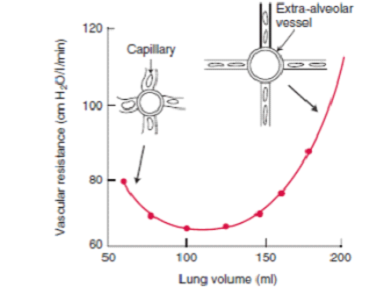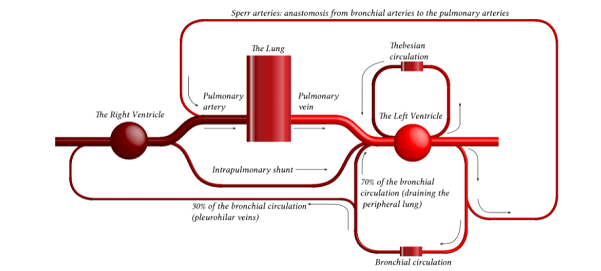F5i / 20B13: Describe the anatomical (20% marks) and physiological (80% marks) features of the pulmonary circulation.
20B13: Exam Report
Describe the anatomical (20% marks) and physiological (80% marks) features of the pulmonary circulation.
25% of candidates passed this question.
The examiners consider that an understanding of the pulmonary circulation is core area of the syllabus. In general, the anatomy section was better answered than the physiological features. As well as a description of the gross anatomy of the pulmonary circulation tracking it from the pulmonary valve to the left atrium, some mention of the microscopic anatomy was required (e.g., that the pulmonary arteries are thin walled with little smooth muscle).
For the second part of the question, a breadth of knowledge was required. Candidates were expected to address the following physiological features of the pulmonary circulation: volume, pressure, resistance, regulation and regional distribution and function. Marks were apportioned to each section, so it was important to write something on each section. Focussing on one
section in detail (e.g., a very detailed description of West’s Zones) usually came at the expense of missing one or more of the other sections, most commonly the functions of the pulmonary circulation. Indeed, candidates that scored well provided information on each section and for the functions of the pulmonary circulation mentioned more than gas exchange.
F5i / 20B13: Describe the anatomical (20% marks) and physiological (80% marks) features of the pulmonary circulation.
Anatomy
⦁ Thin walled arteries and veins, contains little smooth muscle -> easily distorted by lung expansion
⦁ Pulmonary arteries (deoxygenated blood) -> pulmonary capillaries (gas exchange) -> pulmonary veins (oxygenated blood)
⦁ Pulmonary capillaries are exposed to alveolar pressure and not supported by solid tissue -> prone to collapse
⦁ Contains 10% of circulating blood volume – 500mls
Physiology
General
⦁ Low pressure 25/8 MPAP 15mmHg
⦁ Low resistance 20-120 dynes.sec.cm-5
⦁ Flow: total of cardiac output 5L/min
Pulmonary Blood Volume
⦁ ~500mls of blood – blood reservoir
⦁ Varies over course of the respiratory and cardiac cycle and in response to gravity
⦁ Varies in response to changes in intrathoracic pressure
Pulmonary Blood Pressure
⦁ Normal PA systolic pressure = 18-25 mmHg
⦁ Normal PA diastolic pressure = 8-15 mmHg
⦁ Normal mean pulmonary arterial pressure = 9-16 mmHg
⦁ Capillary pressure is 8-10 mmHg
⦁ Venous pressure 6-12 mmHg
Resistance
⦁ The resistance in the pulmonary circulation can be calculated as follows:
⦁ PVR = 80 × (mPAP- PAOP)/CO
⦁ The normal value for PVR is 100-200 dynes/sec/cm-5
⦁ Approximately 1/10th of systemic circulation
Regulation of Blood Flow/Resistance
- West zones
– In zone 1, PA > Pa > Pv No flow of blood
– In zone 2, Pa > PA > Pv Resistance to flow is determined by alveolar pressure (Starling resistor effect)
– In zone 3, Pa > Pv > PA Resistance to flow is determined by venous pressure Venous pooling causes increased distension of pulmonary capillaries
-In zone 4 Low lung volume causes narrowing of extra-alveolar vessels - Lung volumes

⦁ Hypoxia – pulmonary hypoxic vasoconstriction
Regional Distribution
⦁ Distension of partially collapsed capillaries
⦁ Recruitment of completely collapsed capillaries
⦁ Local mediators: NO, prostacycline
Function
⦁ Gas exchange
⦁ Filtration of clots and debris
⦁ Immunological – pulmonary macrophages, IgA production
⦁ Metabolic – metabolism of drugs, removal of proteases
⦁ Endocrine – source of ACE
